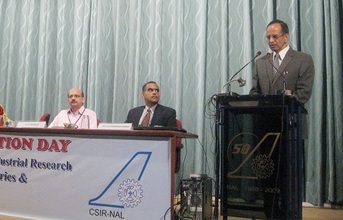
The "Make in India" concept in the Defence Sector has potential to raise defence manufacturing in the country from present 30% to 70% in the next few years. "This could be achieved by making India hub of MRO business, by investing in Research and Technology processes and by focusing on development of skills in 70 plus trades related to the aerospace industry", said Dr. RK Tyagi, Chairman, HAL, at the Foundation Day Celebrations of Council of Scientific and Industrial (CSIR).
Speaking on the occasion, Dr Tyagi outlined a five point agenda for galvanising the Research and Development scenario in the country. The first step towards a better R&D set up is to increase the funding to the national research laboratories such as NAL significantly as they safeguard and protect the country's IP.
The second point is to create an agency which is dedicated to disruptive research ideas within India on the lines of DARPA under Department of Defence in US, Phantom works in Boeing or Skunk works in Lockheed Martin. This agency would help us achieve the success that Atomic Energy or Space Sector has witnessed. He urged that a serious attempt needs to be made to establish a National Aeronautics Commission to synthesise the learnings of the aerospace sector.
Dr Tyagi's third point reflected the point made by the Prime Minister yesterday at Madison square in New York. He stressed that a lot of Indian origin scientists would be more than willing to work in niche areas to prop up the country's capability. A policy framework for engagement of such persons of Indian origin needs to be formulated to fill up the critical technology gaps.
Stressing on higher degree of participation from Industry in R&D, Dr Tyagi's fourth point brought out that one each of the 37 labs of CSIR needs to be adopted by a specific industry or the company so that the lab work gets easily commercialised and is relevant to the needs of the aerospace industry.
He commended the role of CSIR and the National Aerospace Laboratories (NAL) and urged them to open their laboratories to the industries such as HAL and others to exploit the hidden advantages of this scientifically well-established infrastructure. "Such a step will also bring in much needed funds and give fillip to the on-going activities of CSIR-NAL", he added.
(Continued on the next page)





































